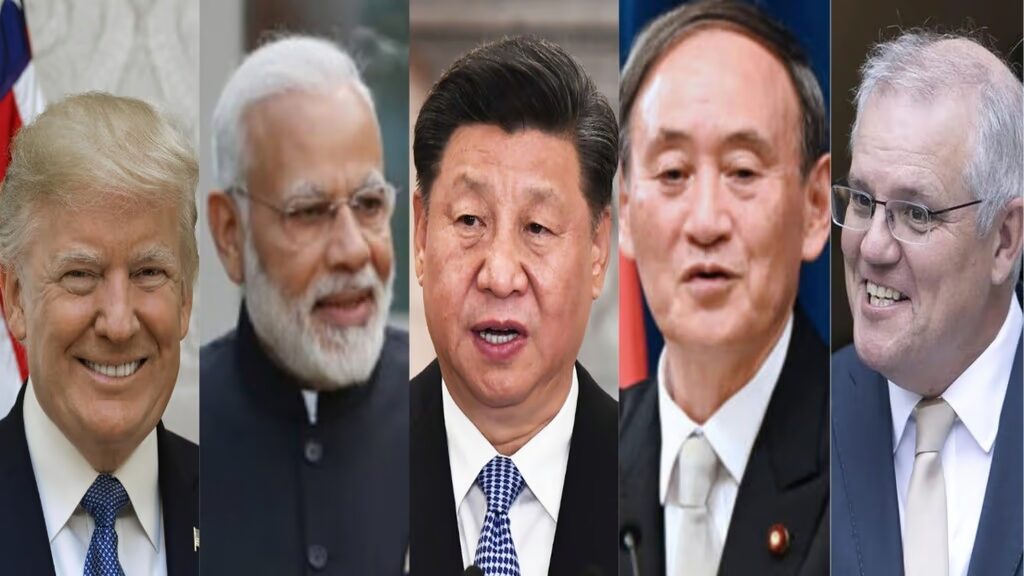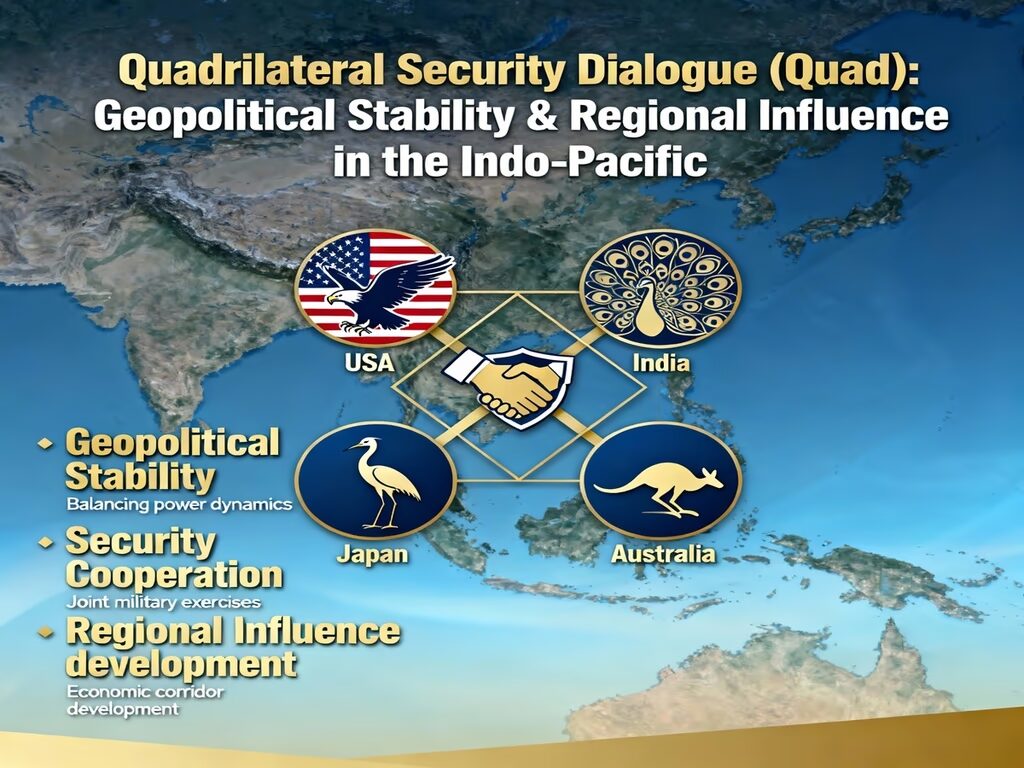
The uncertainties in the QUAD’s decline by the U.S. media have surfaced the tensions in the Indo-Pacific region. The American media hints at fading enthusiasm for the once-celebrated Indo-Pacific alliance of the United States, India, Japan, and Australia. Yet beneath the headlines, the story is far more complex. The Quadrilateral Security Dialogue (QUAD) may be transforming, not terminating. As shifting global priorities, trade challenges, and regional tensions reshape the Indo-Pacific landscape, the QUAD is evolving from a purely strategic bloc into a broader platform for cooperation in technology, infrastructure, and resilience. India’s diplomatic balancing act faces new tests; for the other, China’s dominance in the region confronts a quieter, more adaptive form of counterbalance. Read the following article to understand the ongoing QUAD transformation and the impact on Indo-China relations, and how it matters.
ALSO READ- ISRO Successfully Launches GSAT-7R (CMS-03) Aboard LVM3
What is QUAD?
Quadrilateral Security Dialogue (QUAD) is a strategic union of four significant democratic states, including India, the United States, Japan, and Australia, which come together for mutual common interests in promoting peace, stability, and economic growth in the Indo-Pacific region. It was originally formed in 2007 but later revived in 2017. The QUAD is an informal strategic dialogue and not considered to be an organisation with a headquarters.
Objectives:
- Free and Open Indo-Pacific: All nations can trade, navigate, and cooperate freely without coercion or dominance.
- Enhance defence collaboration, intelligence sharing, and maritime safety by joint exercises to strengthen regional security.
- Support Economic Growth: Build resilient and transparent supply chains that reduce over-dependence on any single nation.
- Advance Technological Cooperation: Cooperate on 5G, AI, cybersecurity, and innovation in clean energy.
- Address Climate Challenges: Collaborate on renewable energy, green infrastructure, and disaster response programs.
- Democratic Values: Promote freedom, the rule of law, and respect for sovereignty.
- Improve Connectivity: Promote digital, infrastructure, and people-to-people links between and among Indo-Pacific countries.

Latest Updates on QUAD-
- In recent discussions, there have been talks of “The QUAD is dead” due to changed priorities by the U.S. and complexities arising out of geopolitics. Nevertheless, the said grouping has been consistently adapting to prove that its relevance is far from over.
- With the reevaluation of the Indo-Pacific strategy by the U.S. administration, some analysts have speculated that Washington’s focus is now shifting from security cooperation to economic diplomacy.
- Contrary to the “QUAD is dead” narrative in sections of the American media, the U.S. State Department holds the view that the QUAD is a vital pillar of its Indo-Pacific vision.
- India continues to reiterate its commitment to QUAD as part of its Act East and Indo-Pacific policies.
- India has recently proposed a QUAD Infrastructure Fund to support digital and green projects in Southeast Asia.
- China has strongly criticised the QUAD, labelling it a “mini-NATO” in Asia.
- Beijing, however, says the grouping is aimed at containing its rise and undermining regional unity.
- However, Chinese state media now portrays the QUAD as “divided and ineffective,” signalling a shift in tone rather than open confrontation.
- There remain differences between QUAD members on trade policy, defence spending, and China engagement.
- The U.S. and Japan favour a more assertive stance, while India and Australia prefer balanced diplomacy. Despite such differences, the leaders have continued to emphasise that the spirit of cooperation remains intact in QUAD.
Role of India in QUAD-
- Strategic Balance: India brings strategic balance in the Indo-Pacific and ensures that the QUAD does not emerge as a platform of confrontation, but cooperation.
- Act East Policy: Through the QUAD, India reinforces its Act East Policy by deepening the relationship with Japan, Australia, and the U.S. to ensure peace and economic growth in the Indo-Pacific.
- Maritime Security: India is actively involved in various initiatives pertaining to maritime security and joint naval exercises like Malabar, ensuring freedom of navigation and combating piracy and other illegal activities.
- Technology & Innovation: India takes the lead in the discussions related to cybersecurity, AI, and critical technologies that help in creating resilient digital frameworks amongst the QUAD members.
- Supply Chain Resilience: It supports regional efforts toward supply chain diversification and reduced reliance on single-country manufacturing. It goes in tune with its Make in India mission.
- Disaster Relief & Climate Action: India cooperates on humanitarian assistance, disaster management, and clean energy projects, strengthening its position as a world leader on sustainability issues.
- The only non-allied member, India, plays the role of a diplomatic bridge with the West and developing nations to keep QUAD inclusive and multipolar.
ALSO READ- A New Moon of Earth? 2025 PN7 Explained
QUAD’s Impact on China-
- Strategic Concern: The QUAD is often seen by China as counterbalancing its increasing influence in the Indo-Pacific, thus creating a possible encirclement or containment.
- Military Pressure: Joint naval exercises like Malabar and increased defence cooperation among QUAD members have strengthened maritime security, indirectly limiting China’s assertive moves in the South China Sea.
- Economic Challenge: QUAD initiatives on supply chain diversification reduce dependence on Chinese manufacturing, challenging the economic supremacy that Beijing enjoys in the long run.
- Technological Rivalry: QUAD nations are cooperating on emerging technologies like 5G, AI, and cybersecurity, acting as a barrier for China’s technological expansion and, more specifically, its Belt and Road Digital Strategy.
- Diplomatic Tensions: The strengthening of QUAD has led China to expand diplomatic outreach to Southeast Asian nations as a means of balancing its image and maintaining regional influence.
- Global Perception: The advocacy of a Free and Open Indo-Pacific by QUAD changed world narratives toward the requirements for transparency and rules-based international order, thereby subtly critiquing China’s regional policies.

Concerns on the Regional Power Balance-
- Shift in Strategic Influence: The formation and consolidation of the QUAD marked a strategic shift of influence in the Indo-Pacific, which had for a long time been dominated by China.
- Polarisation of Security: Most Southeast Asian countries fear that their region would get polarised into the QUAD and China-led blocs, which would heighten military tensions.
- Arms Race Possibility: Increased defence cooperation and military exercises among QUAD members could lead to an arms buildup in the region because countries would want to advance their interests.
- ASEAN’s Neutrality Challenge: With the growing influence of QUAD, ASEAN nations are put under pressure to take sides, which goes against the policy of neutrality and regional harmony of the organisation.
- Economic Realignment: Trade and investment strategies are gradually shifting toward QUAD-friendly supply chains, reducing China’s leverage while creating economic uncertainty for smaller nations.
- Debate on Strategic Autonomy: Countries like India turn towards a balanced approach that guarantees cooperation in QUAD, keeping it independent of both Western and Chinese dominance.
- Long-Term Impact: While QUAD aspires to uphold peace, its burgeoning might could be a game-changer in altering the geopolitical topography of Asia with new partnerships and strategic rivalries.
Conclusion-
The QUAD is not collapsing but changing to meet new geopolitical and economic realities in the Indo-Pacific. Though differing on a few issues, the shared objectives of ensuring a Free, Open, and Inclusive Indo-Pacific keep the alliance intact. Beyond defence, the addition of technology cooperation, climate action, and regional development has added heft to its long-term vision. For Asia, the QUAD serves as a balancing force against growing unilateralism and regional dominance. It offers strategic choices for smaller countries, which also contributes to pan-regional stability through cooperation, not confrontation. As global challenges change with each passing day, adaptability and unity will shape the future role of the QUAD in maintaining peace, prosperity, and a balance of power across the Indo-Pacific.
